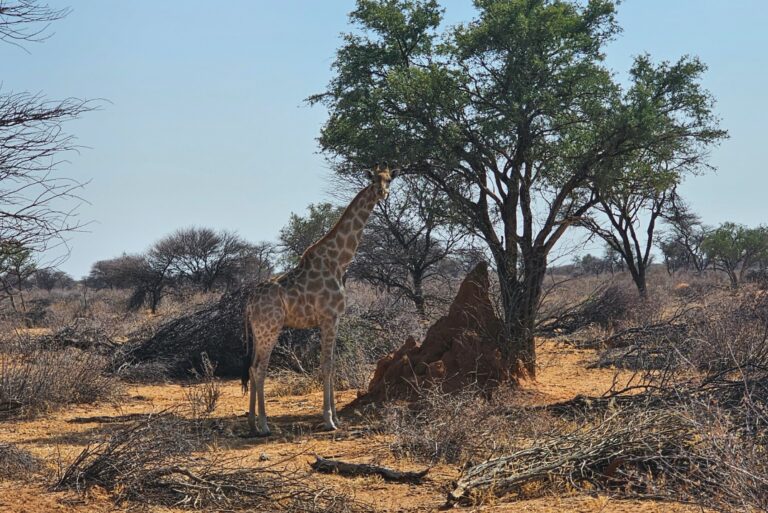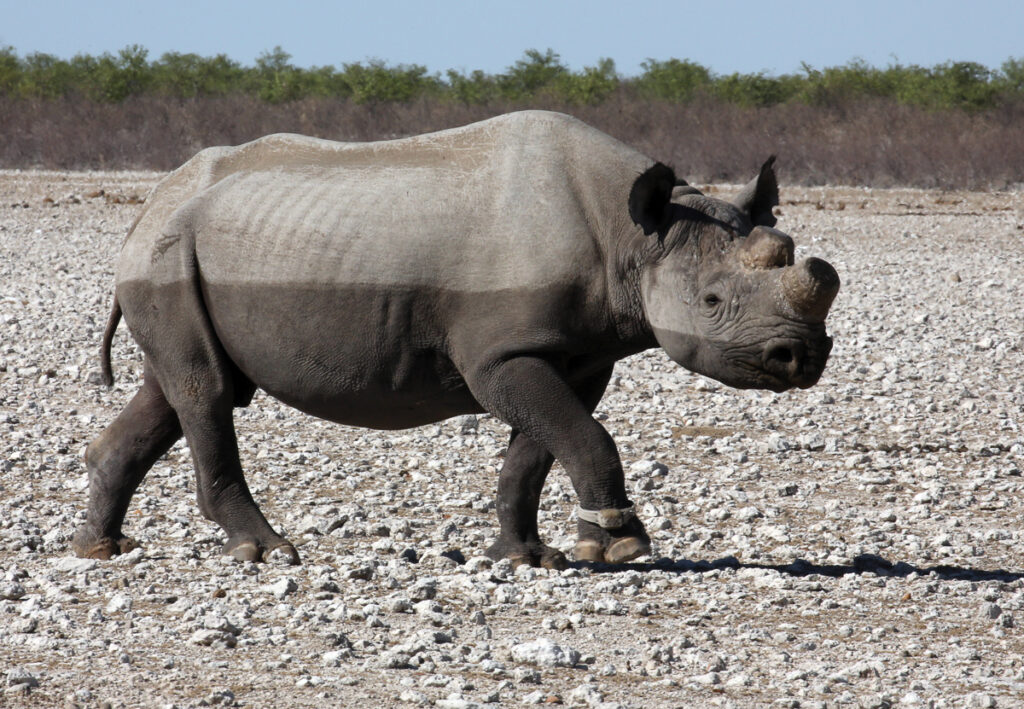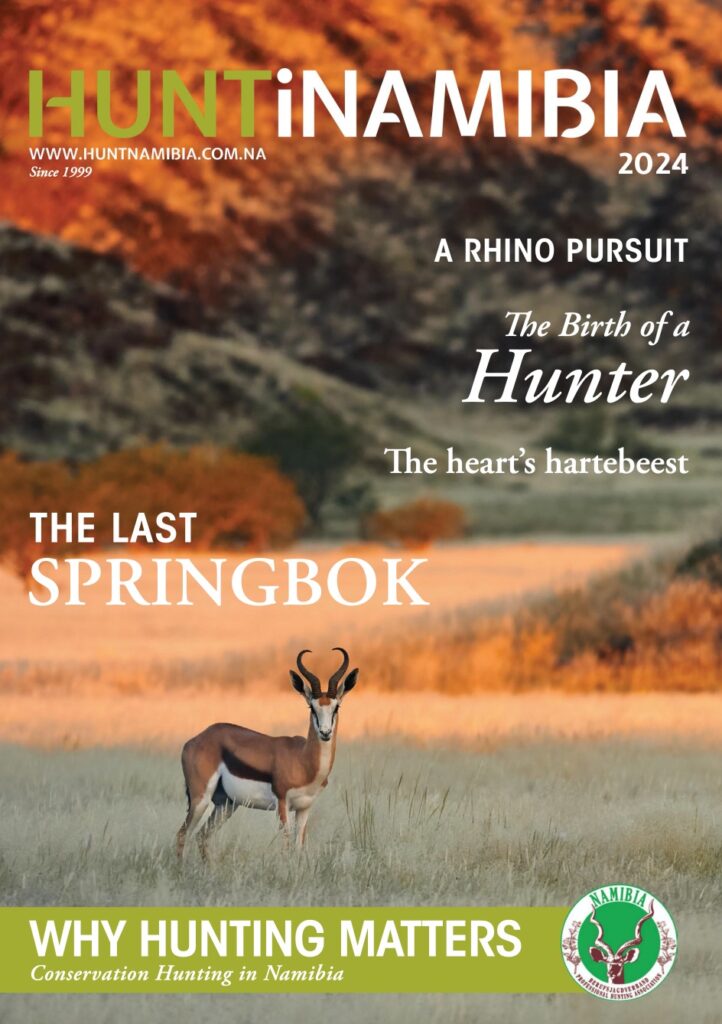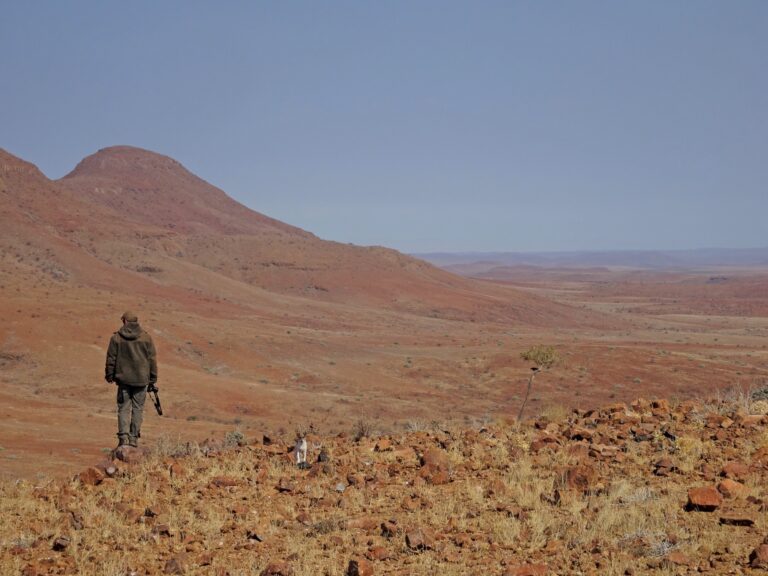One of the pilots has spotted a black rhino (Diceros bicornis bicornis) and alerts the teams over the radio. Soon the rhino is down in the thick thorny bush and everybody has to walk quite a distance to get to the young female. Within twenty minutes the rhino is dehorned by Environment Minister Pohamba Shifeta, DNA samples are taken, any small wounds treated, the horns and off-cuts sealed in a plastic bag in the presence of a police officer, the animal measured and marked. Everybody gets back into the vehicles and helicopters, the veterinarian injects an antidote and a few minutes later the rhino wakes up and disappears into the bush.
Half an hour later the next rhino, a big bull who had been dehorned five years before for the first time, is down. And again the Minister cuts off the horn with an electric saw.
Since 2014 close to 2000 rhinos have been dehorned in Namibia. This year (2023) nearly 200 have been dehorned already. Minister Shifeta was present at the end of May and dehorned two black rhino himself, the aforementioned young cow and old bull.
Holding the horn of the bull in his hand, Minister Shifeta said: “This horn is totally worthless to us, but to poachers and their syndicates it is worth millions. Only trophy hunting adds value to a rhino horn but we have to cut the horns off to make the rhino worthless for the poachers.” The Minister added that rhinos are valuable for tourism but now tourists have to look at rhinos without horns because of the criminal and illegal doings of poachers, their syndicates and the buyers of horns – a useless material. “We rather have living, dehorned black and white rhinos in the country than those with horns which get killed for their horn,” Shifeta said.
“If we could sell those horns that we have cut off our animals to make them worthless for poachers, we could earn much needed dollars for the protection of our rhinos,” the Minister emphasized. At the moment the horns have to be kept at secret places in huge safes which need to be guarded. The security for a “worthless product” is expensive. The security equipment to safeguard rhinos living in national parks, on commercial farms and in communal conservancies is very expensive, too, and makes men and women of MEFT, of the Namibian Police and the Namibian Defence Force unavailable for other urgent duties because they have to protect these rhinos.
When old post-productive bulls start killing younger bulls to maintain their dominance, and even start to kill cows if kept in small protective areas, these problem bulls have to make way. They are legally hunted by trophy hunters. Namibia and South Africa each have a CITES quota of five rhinos per year. “We do not just kill an animal but try to get as much income as possible out of the problem rhino, and the money generated is solely used for rhino conservation,” the MEFT Minister said. The trophy money earned is paid into the Game Products Trust Fund and not into the state coffers.
Four rhinos were trophy-hunted in Namibia in 2022, in 2021 and 2020 one each, in 2019 none, in 2018 one and in 2017 two. Hunters have to cough up between 200 000 and 350 000 US Dollars for a black rhino bull.
Females are not hunted and stay productive until they die a natural death. One female calf whose mother had been poached was saved and subsequently raised on a private game farm. She recently gave birth to her 11th calf.
Rhino conservation is not a cheap and easy way to conserve a species. According to the Chief Conservation Scientist and National Rhino Coordinator of MEFT the costs of dehorning a single rhino are between N$10 000 and N$12 000. This amount doubles if rhinos are dehorned in places like the arid Kunene Region where fewer rhinos are found in much larger areas. The costs of a helicopter is on average around N$18 000 per hour, drugs for darting the animals +/- N$2 000 per rhino, plus the costs for off-road vehicles, salaries and overtime for staff.
Every rhino has its own ID number and DNA sample which is stored in a central lab in South Africa. “We dehorn our rhinos in parks, in custodianship on commercial farms and communal conservancies every second year,” the Chief Conservation Scientist explains. “We know most of our rhinos since they were born, we know how old they are and we age them by their teeth when we dart them to either dehorn or translocate them.” All black rhinos in Namibia are owned by the state.
More than ten years of drought in the arid Kunene Region have had a major effect on the free-ranging rhino population in the communal conservancies. Here, the Save the Rhino Trust does tremendous work and the communities have started to benefit from rhino walks for tourists. The drought started in 2012, and two years later 18 rhinos were poached, the highest number in the last ten years in that area. Because the rhinos are scattered over a huge area, the ruthless criminals concentrated on cows with bigger calves. They killed the cow-and-calf pair to remove the horns, but actually killed three rhinos in the process, because most of the cows were again pregnant at the time, says MEFT´s Chief Conservation Scientist. Fourteen calves were born in 2015, the second highest birth rate in the last ten years, and 15 were born in 2018. But the long drought took its toll and in 2020 the natural mortality was the highest: 20 animals were found dead, mainly calves and old rhinos.





